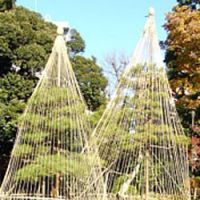Dear Alice,
I know Japanese are into some pretty interesting things when it comes to rope, but does "tree bondage" happen to be one of them? The other day I visited the Kyu-Shibarikyu garden near Hamama- tsucho Station in Tokyo, where I was surprised to see a pine tree imprisoned in a rope cage. There was a pole, taller than the tree, that had been erected next to the trunk, and down from that, on all sides, ran sturdy ropes pulled tight and out to form a triangular tepee that completely encased the poor pine. Is this intended to make the tree grow in a particular way? The pine was way taller than me and growing in the ground (not a pot), so I'm sure this wasn't a bonsai. What the heck is it?
Peter S., Tokyo Dear Peter,
That structure is called a yukitsuri and is intended to protect the tree from snow damage. Given that we haven't had any snow in Tokyo this winter, and no real snowfall to speak of in any year in recent memory, I'm not surprised you couldn't figure out what it was. But in areas that get lots of heavy, wet snow, such structures are truly needed to support tree branches so they don't break when weighted down with snow.
You're most likely to see a yukitsuri, which literally means "snow suspension," in Toyama, Ishikawa and Fukui, three prefectures in the central part of the country along the coast of the Sea of Japan. Every winter this entire region is subject to frequent dumps of snow that is so soggy that any significant accumulation can and does break off tree branches.
The single most famous place for yukitsuri is Kenrokuen, a spacious landscape garden in Kanazawa, Ishikawa Prefecture, that is rated as one of the three most beautiful traditional gardens in Japan. Starting in early November, Kenrokuen gardeners tie up pines, cherry trees and Japanese maples, creating a unique winter landscape that draws crowds of tourists.
Just for fun, I decided to test the Kenrokuen-yukitsuri association by playing a little game with my Japanese friends. It went like this: I'd say, "Yukitsuri to iu to? (If I say yukitsuri, what do you think of?)", to which I was sure the answer would be a resounding "Kenrokuen!" Instead, I got blank stares. "Um, what's a yukitsuri?" they'd ask. When I explained, then they'd get it: "Oh, you mean like in Kenrokuen in Kanazawa?" Mixed success, but give it a try. Maybe your friends are smarter than mine.
Meanwhile, I was very lucky to land an interview with Toshiaki Yonebayashi, the head of operations at Kenrokuen and a master roper who has surely lassoed more trees than anyone else in the world.
In his 38 years at Kenrokuen, he's tied up something like 300 trees every winter. (Do the math: that's 11,400 trees!) I asked Yonebayashi who the heck came up with the idea to tie trees in this fashion, but he said no one really knows.
The oldest surviving record dates from late in the Edo Period (1603-1867). It instructs Kenrokuen gardeners to "tie trees to prevent snow damage," but makes no mention of specific techniques. The type you saw, which is pictured in the photograph that accompanies today's column, is called ringotsuri (apple suspension). Yonebayashi guesses that it was developed some time after apple saplings were first brought to Japan in the 1870s, as a way to support the weight of the fruit.
Erecting a ringotsuri is a delicate operation that requires a whole team of workers. At Kenrokuen, one man climbs the pole and tosses down coils of rope that have been fixed at one end to the top of the pole. Ten other workers stay below to catch the coils, then climb ladders and tie the ropes at strategic points to support the branches and create a visually balanced composition. An experienced team can put up one ringotsuri over an average tree in about two hours. But a very large tree, like the massive Karasaki pine trees in Kenrokuen, can require up to five ringotsuri structures and a full day of work for an entire team.
You don't usually see yukitsuri in the other regions known for snow, including Aomori Prefecture and Hokkaido, because their snow is drier and lighter. In Tokyo, landscape gardens such as Hamarikyu in Minato Ward and Kansen-en in Shinjuku Ward may put up a yukitsuri, but it's really just to showcase a traditional gardening technique and lend a seasonal feel to the winter landscape.
Nice, but it would feel a whole lot more like winter if we'd only get some snow!

















With your current subscription plan you can comment on stories. However, before writing your first comment, please create a display name in the Profile section of your subscriber account page.